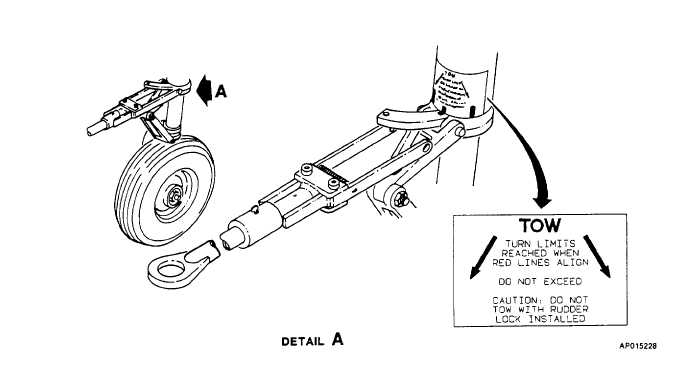TM 1-1510-223-10
Figure 2-42. Towing Turn Limits
2-106. MOORING.
The aircraft is moored to ensure its immovability,
protection,
and
security
under
various
weather
conditions. The following paragraphs give, in detail, the
instructions for proper mooring of the aircraft
a.
Mooring Provisions. Mooring points (fig. 2-43) are
provided beneath the wings and tail. Additional mooring
cables may be attached to each landing gear. General
mooring equipment and procedures necessary to moor
the aircraft, in addition to the following, are given in TM
55-1500-204-25/1.
(1)
Use mooring cables of 1/4 inch diameter air-
craft cable and clamp (clip-wire rope), chain, or rope
(3/4 inch diameter or larger). Length of the cable or
rope will be dependent upon existing circumstances.
Allow sufficient slack in ropes, chains, or cable to
compensate for tightening action due to moisture
absorption of rope or thermal contraction of cable or
chain. Do not use slip knots. Use bowline knots to
secure aircraft to mooring stakes.
(2)
Chock the wheels.
b.
Mooring Procedures for High Winds. Structural
damage can occur from high velocity winds; therefore, if
at all possible, the aircraft should be moved to a safe
weather area when winds above 75 knots are expected.
Moored air- craft condition is shown in figure 2-43. If
aircraft must be secured, use the following steps:
1.
After aircraft is properly located, place nose
wheel in centered position. Point the aircraft
into the wind, or as nearly so as is possible
within limits determined by locations of fixed
mooring rings. When necessary, a 45 degree
variation of direction is considered to be
satisfactory. Locate each aircraft at slightly
more than one wing span distance from all
other air- craft Position nose mooring point
approximately 3 to 5 feet downwind from
ground mooring anchors.
2.
Deflate nose wheel shock strut to within 3/4
inch of its fully deflated position
3.
Fill all fuel tanks to capacity, if time permits.
4.
Place wheel chocks fore and aft of main gear
wheels and nose wheel. Tie each pair of
chocks together with rope or join together with
wooden cleats nailed to chocks on either side
of wheels. Tie ice grip chocks together with
rope. Use sandbags in lieu of chocks when
air- craft is moored on steel mats. Set parking
brake as applicable.
2-95

